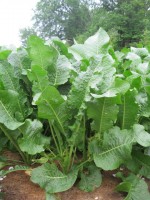 This herbaceous perennial is a member of the mustard family, Brassicaceae, that also includes broccoli, alyssum, and stock. It’s origin is obscure but it is believed to be native to eastern Europe and western Asia. The plant has long, white, tapering root and grows 2-3′ tall. Its coarse leaves are dark green, shiny, and toothed and its small, white fragrant flowers are carried in terminal racemes in mid-summer. Horseradish likes full sun and a rich, loose, deeply cultivated, moist, well-drained soil but tolerates some shade. It is hardy in zones 5-9 but the root does not develop good flavor unless subjected to frost. Propagation is by root division in early spring. Because the plants are vigorous and fairly large they can crowd out most weeds and spread invasively especially if the roots are not harvested every year. The common name, horseradish, comes from the words horse in the sense of coarse, and radish, which its root resembles. The genus name, Amoracia, is the classical Latin name for a related plant. The specific epithet, rusticana, is the Latin word meaning pertaining to the country.
This herbaceous perennial is a member of the mustard family, Brassicaceae, that also includes broccoli, alyssum, and stock. It’s origin is obscure but it is believed to be native to eastern Europe and western Asia. The plant has long, white, tapering root and grows 2-3′ tall. Its coarse leaves are dark green, shiny, and toothed and its small, white fragrant flowers are carried in terminal racemes in mid-summer. Horseradish likes full sun and a rich, loose, deeply cultivated, moist, well-drained soil but tolerates some shade. It is hardy in zones 5-9 but the root does not develop good flavor unless subjected to frost. Propagation is by root division in early spring. Because the plants are vigorous and fairly large they can crowd out most weeds and spread invasively especially if the roots are not harvested every year. The common name, horseradish, comes from the words horse in the sense of coarse, and radish, which its root resembles. The genus name, Amoracia, is the classical Latin name for a related plant. The specific epithet, rusticana, is the Latin word meaning pertaining to the country.
Horseradish is known from ancient times. Greek mythology, the Greek physician Dioscorides record its value while a mural in Pompeii and the writings of the Roman writers Cato and Pliny the Elder attest to its presence among the ancient Romans. During the Middle Ages the leaves and root were used as medicine but by the 16th century English plantsman John Gerard noted that the Germans used it with vinegar as a sauce to eat fish and other meats. A little later the London apothecary and botanist John Parkinson mentions that horseradish was a condiment for “country people and strong labouring men.” Both Washington and Jefferson mention the plant in their farm records.